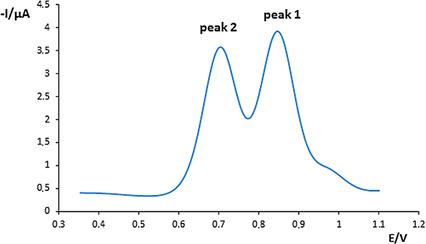当前位置:
X-MOL 学术
›
Electroanalysis
›
论文详情
Our official English website, www.x-mol.net, welcomes your feedback! (Note: you will need to create a separate account there.)
Screen‐printed Electrodes for the Determination of Iridium in Drugs
Electroanalysis ( IF 3 ) Pub Date : 2018-10-16 , DOI: 10.1002/elan.201800502 Marc Zaguirre 1 , Cristina Ariño 1 , Núria Serrano 1 , José Manuel Díaz‐Cruz 1 , Miquel Esteban 1
Electroanalysis ( IF 3 ) Pub Date : 2018-10-16 , DOI: 10.1002/elan.201800502 Marc Zaguirre 1 , Cristina Ariño 1 , Núria Serrano 1 , José Manuel Díaz‐Cruz 1 , Miquel Esteban 1
Affiliation

|
Among the impurities that must be controlled in drugs and pharmaceuticals, metal ions are considered. These metal impurities appear in those products because of their use as catalysts. Although Pharmacopeias recommend ICP based methods for their determination, the use of electroanalytical techniques can be considered as a sensible, selective and non‐expensive alternative for the determination of heavy metal ions in general and metal impurities in particular. In the present work, we propose a differential pulse voltammetric method based on the use of carbon based‐screen‐printed electrodes (graphite, nanotubes or nanofibers) that allows the determination of iridium in drugs at the concentration limits recommended by official organisms. Carbon screen‐printed electrode modified with nanotubes (CNT‐SPCE) is the sensor that provided the best LOD and LOQ (0.03 and 0.10 mg L−1 respectively). Then, the proposed method was applied to the voltammetric determination of iridium in spiked drug samples purchased in local chemists using CNT‐SPCE.
中文翻译:

丝网印刷电极测定药物中的铱
在药物和药品中必须控制的杂质中,考虑了金属离子。这些金属杂质由于用作催化剂而出现在那些产品中。尽管药典建议使用基于ICP的方法进行测定,但对于一般性重金属离子特别是金属杂质的测定,电分析技术的使用仍可被视为明智,选择性和非昂贵的替代方法。在当前的工作中,我们提出一种基于碳基丝网印刷电极(石墨,纳米管或纳米纤维)的差分脉冲伏安法,该方法可以在官方生物体推荐的浓度极限下测定药物中的铱。-1)。然后,将所建议的方法应用于使用CNT-SPCE在当地化学家购买的加标药物样品中的伏安测定。
更新日期:2018-10-16
中文翻译:

丝网印刷电极测定药物中的铱
在药物和药品中必须控制的杂质中,考虑了金属离子。这些金属杂质由于用作催化剂而出现在那些产品中。尽管药典建议使用基于ICP的方法进行测定,但对于一般性重金属离子特别是金属杂质的测定,电分析技术的使用仍可被视为明智,选择性和非昂贵的替代方法。在当前的工作中,我们提出一种基于碳基丝网印刷电极(石墨,纳米管或纳米纤维)的差分脉冲伏安法,该方法可以在官方生物体推荐的浓度极限下测定药物中的铱。-1)。然后,将所建议的方法应用于使用CNT-SPCE在当地化学家购买的加标药物样品中的伏安测定。


























 京公网安备 11010802027423号
京公网安备 11010802027423号